
50×12.5: 8.50×12.5: Understanding Digital Codes and Their Use
The exploration of 50×12.5: 8.50×12.5: Understanding Digital Codes and Their Use reveals their critical role in the architecture of contemporary communication systems. These codes not only serve as foundational elements in data encoding but also impact various industries by enhancing data integrity and transmission efficiency. As we navigate the complexities of an increasingly digital world, understanding the implications of these coding methods becomes paramount. What innovations might emerge as technology advances further? The answers could redefine our approach to digital communication and information security.
Definition of Digital Codes
50×12.5: 8.50×12.5: Understanding Digital Codes and Their Use refer to systematic representations of information that can be processed, transmitted, and stored electronically. Utilizing binary representation, these codes convert data into a format suitable for digital devices.
Error detection mechanisms enhance reliability, ensuring that information remains intact during transmission. By embracing digital codes, individuals can safeguard their data while enjoying the freedom to communicate and share information seamlessly in an increasingly digital world.
Read more: 25×2: Understanding the Mathematical Formula 174.25×2
Applications in Various Industries
The implementation of digital codes has revolutionized numerous industries by enhancing data processing, transmission, and storage capabilities.
In sectors such as telecommunications and finance, effective data encoding ensures efficient communication and robust error detection.
Moreover, advanced security protocols safeguard sensitive information, while signal processing techniques optimize data integrity.
These applications empower organizations to operate with greater efficiency and security, ultimately fostering innovation and growth.
Importance of Digital Codes
In today’s data-driven landscape, the significance of digital codes cannot be overstated. They are essential for error detection, ensuring data integrity in transmission.
Furthermore, digital coding facilitates data compression, optimizing storage and bandwidth usage. Adherence to encoding standards enhances interoperability, while robust security protocols protect sensitive information.
Ultimately, digital codes empower users with the freedom to communicate and manage data efficiently and securely.

Future Trends in Digital Coding
As technology evolves, three key trends are poised to shape the future of digital coding: increased reliance on artificial intelligence, the rise of quantum computing, and the expansion of 5G networks.
Quantum coding will enhance error correction and data compression, while machine learning algorithms will optimize coding efficiency.
These advancements promise to revolutionize data transmission, providing greater freedom and reliability for users worldwide.
Read more: 46E+11: A Large Digital Number in Scientific Notation
Conclusion
In conclusion, 50×12.5: 8.50×12.5: Understanding Digital Codes and Their Use represent the backbone of modern communication, weaving an intricate tapestry of connectivity that transcends time and space. The importance of these codes cannot be overstated; they are the silent architects of seamless data exchange and unparalleled security in an increasingly digital world. As industries harness the power of artificial intelligence and quantum computing, the potential for coding sophistication will soar to unimaginable heights, revolutionizing global communication as never before.




